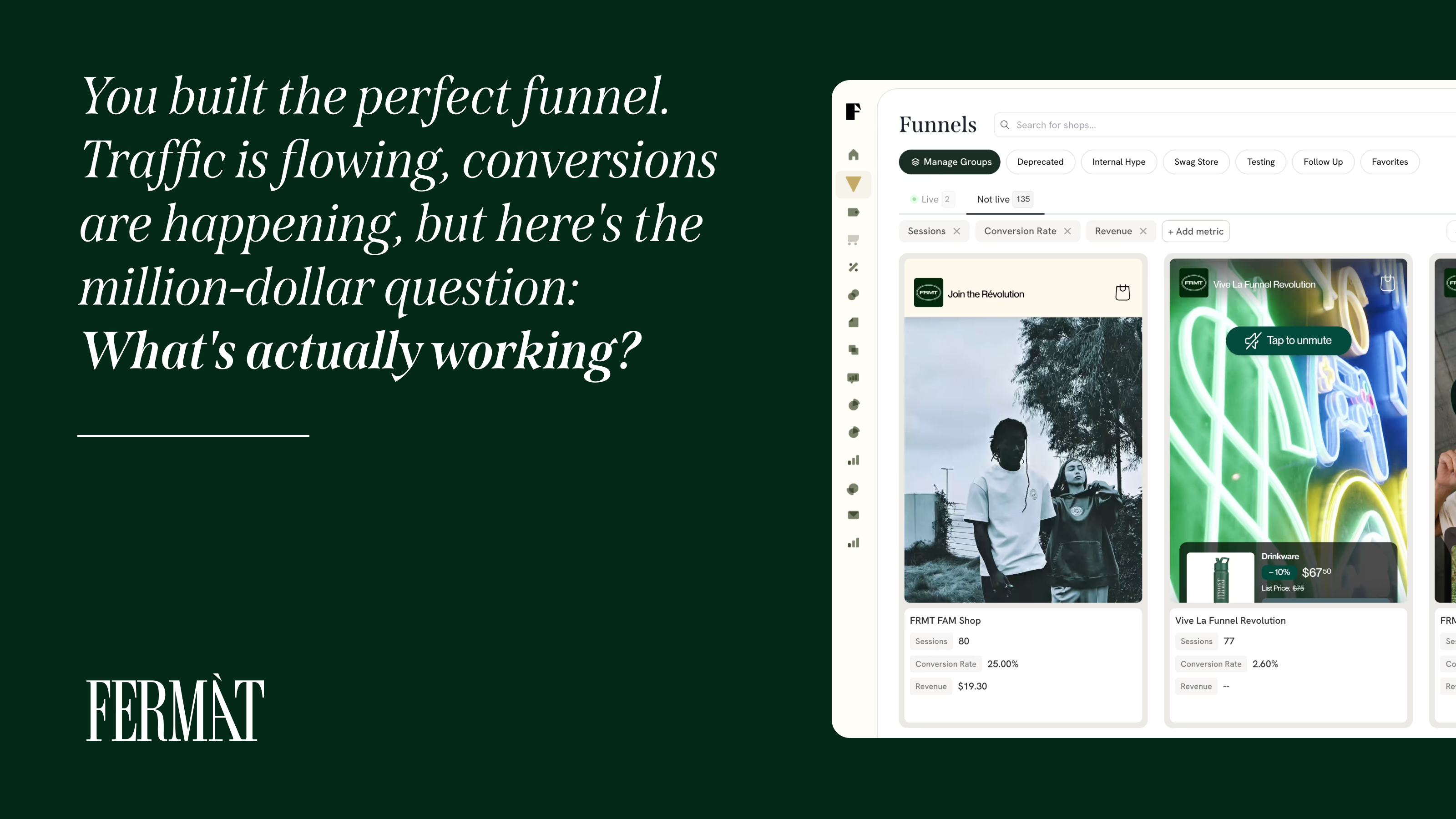
How to Calculate Conversion Rate Landing Page: A Step-by-Step Guide
Conversion rates are an essential metric in assessing the effectiveness of your landing pages.
Calculating the ecommerce-specific conversion rate (i.e., purchase rate) of your landing page is crucial for evaluating the effectiveness of your digital marketing efforts. Divide the number of conversions by the total number of visitors, and then multiply by 100 to get a percentage. This simple formula gives you insights into how well your landing page is converting visitors into customers, a key component of your overall marketing strategy.
By owning your post-click experience, you can effectively convert more paid traffic and maximize your marketing efforts. Whether through ecommerce landing pages, embedded product detail pages, or custom carts, FERMÀT allows you to take control of your digital presence for improved conversion rates and a better return on investment.
Understanding Conversion Rates
Understanding your conversion rate enables you to refine your approach, making necessary adjustments to enhance user experience and drive better results. With tools and strategies in place, you can experiment with different elements of your landing page to optimize performance. FERMÀT offers the best option for creating funnels, enabling you to experiment at scale without needing any coding skills.
Defining Conversion Rates
A conversion rate is the percentage of visitors who take a desired action on your landing page, such as making a purchase, signing up for a newsletter, or requesting more information. To calculate this, use the formula:
Conversion Rate = (Total Conversions / Total Visitors) × 100
For instance, if your landing page receives 1,000 visitors and 50 of them convert, your conversion rate would be 5%. This metric helps evaluate the efficiency of your marketing tactics. By focusing on increasing this rate, you can maximize your returns on investment and make informed decisions in your campaigns.
Relevance to Ecommerce and SaaS
In the context of ecommerce and SaaS, conversion rates play a pivotal role. For ecommerce, a high conversion rate indicates effective product presentations, compelling calls to action, and an optimized user experience. When shoppers engage positively with your landing page, they are more likely to complete purchases.
In SaaS, conversion rates measure how well your services fulfill user needs. Often, this involves free trials or subscriptions, making it crucial to understand user behavior. FERMÀT enables you to build effective online funnels by crafting landing pages that replicate the ad creation process. This means you can enhance post-click experiences, driving higher conversions with minimal coding required.
Key Elements of a High-Converting Landing Page
Creating a high-converting landing page involves a strategic combination of essential elements. Focusing on social proof, effective calls-to-action, and user experience can significantly boost your page's performance and conversion rates.
Incorporating Social Proof
Social proof is a powerful tool that can enhance your landing page's credibility. Including testimonials from satisfied customers can build trust and encourage new visitors to take action.
You might also consider showcasing user-generated content, such as photos or reviews, to highlight real experiences. This creates a sense of community and relatability, making potential customers feel more inclined to engage with your offer.
Showcasing specific metrics—like the number of satisfied users or sales milestones—can further reinforce your page's credibility. Such data serves as validation and can improve conversion rates by instilling confidence in your product or service.
Effective Call-to-Action
Your call-to-action (CTA) is a critical component of your landing page. It should be clear, compelling, and easy to find. Emphasize action-oriented copywriting that creates a sense of urgency, such as “Get Started Now” or “Sign Up Today.”
To make your CTA stand out, use contrasting colors and strategic placement; ideally, it should be above the fold. You can consider using multiple CTAs throughout the landing page to catch users at different points in their decision-making process.
A/B testing your CTA can also yield valuable insights. Experiment with different phrases, designs, and placements to determine which combination drives the highest conversions.
Importance of User Experience
User experience (UX)—also known as ecommerce customer experience (CX)—plays a vital role in keeping visitors engaged and guiding them toward conversion. An intuitive layout and straightforward navigation can significantly impact how users interact with your landing page.
Ensure your page loads quickly, as slow loading times can lead to high bounce rates. Optimizing images and streamlining code are effective ways to enhance page speed.
Incorporating responsive design is also essential; your landing page should work seamlessly across all devices. Remember, a well-designed landing page not only attracts visitors but also retains them, ultimately leading to increased conversions.
With FERMÀT, you can create funnels that convert like ads, optimizing your landing pages for better performance every time.
Calculating Landing Page Conversion Rates
Understanding how to calculate your landing page conversion rates is essential for optimizing your marketing efforts. Accurate calculations enable you to assess performance and make data-driven decisions. Below, you'll find a detailed process for calculating conversion rates, utilizing analytics tools, and interpreting the results effectively.
Step-by-Step Calculation Process
To calculate your landing page conversion rate, follow this simple formula:
Conversion Rate (%) = (Conversions / Total Visitors) × 100
- Determine Conversions: Start by identifying how many visitors completed your desired action, such as filling out a form or making a purchase.
- Count Total Visitors: Next, count the total number of visitors to the landing page during the same period.
- Apply the Formula: Divide the total conversions by total visitors and multiply by 100 to find your conversion rate. For instance, if 300 out of 2,000 visitors converted, your calculation will look like this: (300 / 2000) × 100 = 15%.
Using this rate, you can benchmark your performance against industry standards to understand where you stand.
Utilizing Analytics Tools
Leveraging analytics tools is crucial for accurate conversion tracking. Google Analytics is a powerful option for this purpose.
- Set Up Goals: In Google Analytics, establish specific goals that align with your conversions. This could include sign-ups, purchases, or downloads.
- Monitor Traffic Sources: Analyze the traffic to your landing page. Understanding where your visitors come from helps you identify which channels are driving the most conversions.
- Evaluate Behavior: Review user behavior on your landing page, including bounce rates and time spent on the page. This data can inform adjustments needed for improved performance.
By utilizing these analytics tools effectively, you can gain deeper insights into visitor interactions and conversion pathways.
Interpreting the Results
Interpreting your conversion rate results requires context. A benchmark conversion rate varies, but generally, 2-5% is considered average for many industries.
When assessing your rate:
- Compare to Benchmarks: Look for industry-specific benchmarks to gauge your performance. If you're below average, consider identifying potential friction points on your landing page.
- Analyze Trends: Observe how your conversion rate changes over time. A consistent downward trend may signal issues in your marketing strategy or landing page effectiveness.
- Segment Your Data: Evaluate your conversion rates across different segments such as demographics or traffic sources. This granularity helps you tailor your strategies for better outcomes.
By focusing on these areas, you can refine your approach and enhance your landing page’s impact. FERMÀT provides tools for creating optimized funnels, allowing you to experiment freely without coding. This way, you can maximize your post-click experience and improve conversion rates.
Strategies for Conversion Rate Optimization (CRO)
Effective conversion rate optimization requires targeted strategies aimed at enhancing user engagement and driving actions on your landing page. From testing various elements to ensuring your website performs seamlessly across devices, consider the following approaches.
A/B Testing for Improvement
A/B testing allows you to compare two versions of a landing page to determine which performs better. You can test elements such as headlines, images, and calls-to-action.
For example, you might create one version with a bold headline and another with a more subtle approach. By analyzing user behavior, you can identify which version results in a higher conversion rate.
This process not only helps refine your design but also informs you about customer preferences. Implement A/B tests regularly to keep optimizing your page. FERMÀT enables you to run these experiments seamlessly, providing you insights into what drives conversion.
Personalization and Segmentation
Personalization involves tailoring your landing page content to meet the needs of specific audience segments. Utilizing data from user behavior and demographics, you can deliver a customized experience that resonates with individual users.
For instance, show different offers based on user location or referral source. Segmenting your audience allows you to deploy targeted messages that can significantly improve engagement. Personalized content makes users feel valued and understood, which can lead to higher conversion rates.
Tools integrated with FERMÀT make it easy to personalize your landing pages without needing extensive coding knowledge.
Mobile Optimization Practices
With an increasing number of users accessing websites via mobile devices, optimizing your landing page for mobile is crucial. Ensure that your page loads quickly and is visually appealing on smaller screens.
Utilizing responsive design allows elements to adapt to various screen sizes automatically. Streamline navigation and reduce the number of fields in forms for ease of use.
Testing your mobile version is essential; consider how it feels to interact with your page on a smartphone. With FERMÀT, you can experiment with mobile-specific layouts, ensuring that your post-click experience delivers excellent results across all devices.
Monitoring and Enhancing Conversion Performance
To effectively boost your landing page's conversion rate, it is crucial to monitor performance through analytics and continuously enhance your strategies. Understanding how to analyze data will guide your decisions, while iterative improvements will refine your techniques over time.
Understanding Analytics and Reporting
Start by setting up conversion tracking to gather data on how well your landing pages perform. Use tools like Google Analytics to monitor visitor behavior, traffic sources, and the actions users take on your site. Pay attention to key metrics such as conversion rate, bounce rate, and the average time spent on the page.
Create a reporting schedule to review these metrics regularly. This will help you identify trends related to your marketing campaigns. For example, if certain ads drive high traffic but low conversions, it may indicate a mismatch between the ad's messaging and the landing page design. Utilize A/B testing to experiment with different design elements and calls to action, allowing you to compare their effectiveness based on real data.
Continuous Improvements and Updates
Continuous improvement is essential for enhancing conversion performance. Regularly update your landing page content to reflect seasonal promotions or changes in your product offerings. This keeps your page relevant to your audience and can improve engagement.
Leverage user feedback to make informed changes. Conduct surveys or use on-page chat tools to understand visitor concerns. Implement changes based on this data and track results to see if they lead to improved conversions.
With FERMÀT, you can effectively manage your post-click experience. Crafting landing pages, embedded PDPs, and custom carts with no-code experimentation empowers you to optimize your funnels just as you would your advertisements. This leads to higher ROI and better overall website performance.

